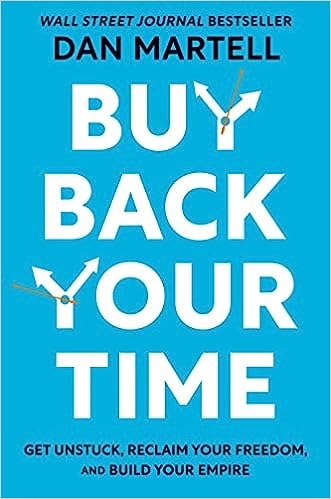
Buy Back Your Time: Get Unstuck, Reclaim Your Freedom, and Build Your Empire - by Dan Martell
Date read: 2023-09-03How strongly I recommend it: 8/10
(See my list of 150+ books, for more.)
Go to the Amazon page for details and reviews.
Written for entrepreneurs but with concepts that can apply to anyone. The author has clearly done his homework by pulling in concepts from Andy Grove, James Clear, Stephen Covey, and Tim Ferriss to name a few, and relabeling them in a way to fit his approach. Good for anyone running their own business or managers looking to find more time to do what matters most.
Contents:
My Notes
Visit BuyBackYourTime.com/Resources for templates and examples.
The little-known secret to reaching the next stage of your business is spending your time on only the tasks that: (a) you excel at, (b) you truly enjoy, and (c) add the highest value (usually in the form of revenue) to your business.
The Buyback Principle: Don't hire to grow your business. Hire to buy back your time.
Examples include:
A Buyback Loop - when you continually audit your time to determine the low-value tasks that are sucking your energy. Then you transfer those tasks, optimally, to someone who's better at them and enjoys them. Lastly, you fill your time with higher-value tasks that light you up and make you more money. Then you start the process over again:
Ask yourself: "What would I fill my time with if I wasn't spending all of it at work?"
You have unique gifts that create real value. Clear out your calendar so you can practice those gifts.
If there's draining work on your to-do list, and someone else can get it done 80% of the way (and do it for the right price) then you should transfer the task.
Buyback Rate Calculation: No one should be performing a work task that they could outsource for one-fourth (i.e., 25%) of their current effective hourly rate. So if your effective hourly rate is $100 an hour, then your Buyback Rate is $25 an hour.
Buyback Rate Formula:
Income ÷ 2,000 hours ÷ 4
Example: $200,000.00 ÷ 2,000 ÷ 4 = $25/h
The 10-80-10 rule: You do the initial 10%, then put someone else in charge of executing on the middle 80% of the work, then you sail back in and finalize the last 10%, putting your magical touch on the project.
If you want your days back, you must get an assistant.
Administrative assistants, at a minimum, should provide two support functions:
- They should systematically manage your calendar.
- They should independently manage your inbox.
Build out SOPs (Standard Operating Procedures) or Playbooks starting with one Playbook in the very place you're having the most pain.
The 4 C's of a Playbook:
- The Camcorder Method (the training videos)
- The Course (the steps involved in the process)
- The Cadence (how often these tasks should be completed: monthly, weekly, dail, etc.)
- The Checklist (the high-level items that must be completed every time)
Inside each Playbook, I have nonnegotiable checklists. "Did you pull in all reports and ensure they were easily readable for recipients?" "Did you schedule a follow-up call with all missed contacts?" "Did you update the software?"
Definition of Done (DoD) needs to have three things:
- Facts - What are the hard metrics that must be accomplished? WHat measurement in your business must be improved?
- Feelings - How must you and others feel for this task to be considered complete?
- Functionality - When this task is finished, what must it enable others to do?
When hiring, I ask every candidate to upload a three-minute (maximum) video of themselves answering five simple questions:
- Why are you interested in this position?
- What do you know about our company?
- What is your ideal work enivornment?
- What are your strengths?
- Where do you see yourself in five years?
- Give them a project that is representative of the actual work we will do together.
- Pay them for their time.
- Don't give many instructions